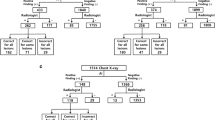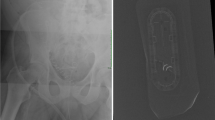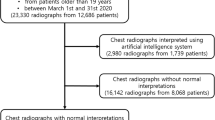Abstract
Background
Early and accurate radiographic diagnosis is required for the management of children with radio-opaque esophageal foreign bodies. Button batteries are some of the most dangerous esophageal foreign bodies and coins are among the most common. We hypothesized that artificial intelligence could be used to triage radiographs with esophageal button batteries and coins.
Objective
Our primary objective was to train an object detector to detect esophageal foreign bodies, whether button battery or coin. Our secondary objective was to train an image classifier to classify the detected foreign body as either a button battery or a coin.
Materials and methods
We trained an object detector to detect button batteries and coins. The training data set for the object detector was 57 radiographs, consisting of 3 groups of 19 images each with either an esophageal button battery, esophageal coin or no foreign body. The foreign bodies were endoscopically confirmed, and the groups were age and gender matched. We then trained an image classifier to classify the detected foreign body as either a button battery or a coin. The training data set for the image classifier consisted of 19 radiographs of button batteries and 19 of coins, cropped from the object detector training data set. The object detector and image classifier were then tested on 103 radiographs with an esophageal foreign body, and 103 radiographs without a foreign body.
Results
The object detector was 100% sensitive and specific for detecting an esophageal foreign body. The image classifier accurately classified all 6/6 (100%) button batteries in the testing data set and 93/95 (97.9%) of the coins. The remaining two coins were incorrectly classified as button batteries. In addition to these images with a single button battery or coin, there were two unique cases in the testing data set: a stacked button battery and coin, and two stacked coins, both of which were classified as coins.
Conclusion
Artificial intelligence models show promise in detecting and classifying esophageal discoid foreign bodies and could potentially be used to triage radiographs for radiologist interpretation.





Similar content being viewed by others
References
Litovitz T, Whitaker N, Clark L et al (2010) Emerging battery-ingestion hazard: clinical implications. Pediatrics 125:1168–1177
Pugmire BS, Lim R, Avery LL (2015) Review of ingested and aspirated foreign bodies in children and their clinical significance for radiologists. Radiographics 35:1528–1538
Semple T, Calder AD, Ramaswamy M, McHugh K (2018) Button battery ingestion in children-a potentially catastrophic event of which all radiologists must be aware. Br J Radiol 91:20160781
Lin VYW, Daniel SJ, Papsin BC (2004) Button batteries in the ear, nose and upper aerodigestive tract. Int J Pediatr Otorhinolaryngol 68:473–479
Kramer RE, Lerner DG, Lin T et al (2015) Management of ingested foreign bodies in children: a clinical report of the NASPGHAN Endoscopy Committee. J Pediatr Gastroenterol Nutr 60:562–574
Mubarak A, Benninga MA, Broekaert I et al (2021) Diagnosis, management, and prevention of button battery ingestion in childhood: a European Society for Paediatric Gastroenterology Hepatology Nutrition position paper. J Pediatr Gastroenterol Nutr 73:129–136
Waltzman ML, Baskin M, Wypij D et al (2005) A randomized clinical trial of the management of esophageal coins in children. Pediatrics 116:614–619
Bernstein JM, Burrows SA, Saunders MW (2007) Lodged oesophageal button battery masquerading as a coin: an unusual cause of bilateral vocal cord paralysis. Emerg Med J 24:e15
Meyer TJ, Grunz J-P, Taeger J et al (2020) Systematic analysis of button batteries', euro coins', and disk magnets' radiographic characteristics and the implications for the differential diagnosis of round radiopaque foreign bodies in the esophagus. Int J Pediatr Otorhinolaryngol 132:109917
Annarumma M, Withey SJ, Bakewell RJ et al (2019) Automated triaging of adult chest radiographs with deep artificial neural networks. Radiology 291:196–202
Lakhani P, Flanders A, Gorniak R (2021) Endotracheal tube position assessment on chest radiographs using deep earning. Radiol Artif Intell 3:e200026
Thian YL, Li Y, Jagmohan P et al (2019) Convolutional neural networks for automated fracture detection and localization on wrist radiographs. Radiol Artif Intell 1:e180001
Meda KC, Milla SS, Rostad BS (2021) Artificial intelligence research within reach: an object detection model to identify rickets on pediatric wrist radiographs. Pediatr Radiol 51:782–791
Yi PH, Kim TK, Wei J et al (2019) Automated semantic labeling of pediatric musculoskeletal radiographs using deep learning. Pediatr Radiol 49:1066–1070
Kawamura R RectLabel. https://rectlabel.com. Accessed 15 May 2021
Apple, Inc. MLObjectDetector. https://developer.apple.com/documentation/createml/mlobjectdetector. Accessed 15 May 2021
Redmon J, Farhadi A (2016) YOLO9000: better, faster, stronger. arXiv preprint arXiv:161208242
Apple, Inc. MLImageClassifier. https://developer.apple.com/documentation/createml/mlimageclassifier. Accessed 15 May 2021
Acknowledgements
Bradley S. Rostad would like to thank Christina Rostad for her critical review of the manuscript, and Ella Rostad for her support. Funding was received from Emory Department of Radiology and Imaging Sciences Seed Grant Program
Author information
Authors and Affiliations
Corresponding author
Ethics declarations
Conflicts of interest
None
Additional information
Publisher's Note
Springer Nature remains neutral with regard to jurisdictional claims in published maps and institutional affiliations.
Rights and permissions
About this article
Cite this article
Rostad, B.S., Richer, E.J., Riedesel, E.L. et al. Esophageal discoid foreign body detection and classification using artificial intelligence. Pediatr Radiol 52, 477–482 (2022). https://doi.org/10.1007/s00247-021-05240-3
Received:
Revised:
Accepted:
Published:
Issue Date:
DOI: https://doi.org/10.1007/s00247-021-05240-3




